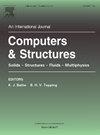Design of compliant thermal actuators using topology optimization involving design-dependent thermal convection and pressure load
IF 4.4
2区 工程技术
Q1 COMPUTER SCIENCE, INTERDISCIPLINARY APPLICATIONS
引用次数: 0
Abstract
This study presents a topology optimization method for thermal actuators that accounts for boundary conditions influenced by variables such as thermal convection and pressure load. Thermal actuators with gripper-like designs are essential for handling hot and brittle materials. The objective of this study is to design actuator shapes that achieve an optimal balance between flexibility and stiffness in high-temperature environments. Unlike previous studies that consider load conditions imposed on fixed boundaries within the design domain, this research introduces a high-temperature fluid as the driving source and employs a novel approach to boundary condition setting by integrating fictitious physical problems. This approach allows for the precise specification of various boundary conditions across multiple domains. A weighted-sum method is applied to optimize three objective functions related to deformability, stiffness, and thermal diffusibility of the actuators. To address the issue of excessively thin structures compromising deformability and the poor convergence of the optimization process, stress constraints based on the optimization history are introduced. The proposed method is validated through numerical examples, demonstrating improvements in structural deformability while controlling deformation on the target surface plane. The numerical results confirm that the objective function decreases and stress is suppressed, verifying the effectiveness of the proposed approach.
基于拓扑优化的柔性热致动器设计,包括与设计相关的热对流和压力负载
本文提出了一种考虑热对流和压力载荷等变量影响的边界条件的热致动器拓扑优化方法。具有夹持式设计的热致动器对于处理热和脆性材料是必不可少的。本研究的目的是设计在高温环境中实现灵活性和刚度之间最佳平衡的致动器形状。与以往的研究不同,该研究引入了高温流体作为驱动源,并采用了一种新颖的方法,通过整合虚拟物理问题来设置边界条件。这种方法允许跨多个域的各种边界条件的精确规范。采用加权和法对致动器的可变形性、刚度和热扩散性三个目标函数进行了优化。为了解决过薄结构影响变形能力和优化过程收敛性差的问题,引入了基于优化历史的应力约束。通过数值算例验证了该方法的有效性,表明在控制目标表面变形的同时,结构的变形能力得到了改善。数值结果表明,目标函数减小,应力得到抑制,验证了该方法的有效性。
本文章由计算机程序翻译,如有差异,请以英文原文为准。
求助全文
约1分钟内获得全文
求助全文
来源期刊

Computers & Structures
工程技术-工程:土木
CiteScore
8.80
自引率
6.40%
发文量
122
审稿时长
33 days
期刊介绍:
Computers & Structures publishes advances in the development and use of computational methods for the solution of problems in engineering and the sciences. The range of appropriate contributions is wide, and includes papers on establishing appropriate mathematical models and their numerical solution in all areas of mechanics. The journal also includes articles that present a substantial review of a field in the topics of the journal.
 求助内容:
求助内容: 应助结果提醒方式:
应助结果提醒方式:


